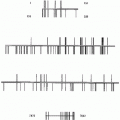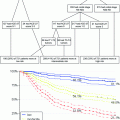Fig. 1
Age-adjusted incidence by calendar year of diagnosis for human papillomavirus (HPV)-related sites (including base of tongue, lingual tonsil, tonsil, oropharynx, and Waldeyer ring) and HPV-unrelated sites (including other and unspecified parts of tongue). Chaturvedi et al. J Clin Oncol 2008
Gillisson et al. (2012) conducted a cross-sectional study, on the statistically representative sample of the civilian non-institutionalized US population (National Health and Nutrition Examination Survey (NHANES) 2009–2010). Men and women aged 14–69 years (N = 5579) examined at mobile examination centers were involved in the study. Participants provided a 30 second oral rinse and gargle with mouthwash. The prevalence of oral HPV infection followed a bimodal pattern with age (Fig. 2), with a first peak in prevalence observed among those aged 30–34 years and a second, higher peak among those aged 60–64 years. Whether these peaks are caused by increased duration of infection over an individual’s lifespan or whether they are caused by an increase in acquisition at older ages is an important epidemiological question. One of the hypotheses is the trend of changing sexual practices with oral sex being performed more by men and women that are currently aged 30–49 years compared to older generations. The second peak, however, cannot be entirely explained by sexual behaviors and could have also arisen from a combination of increased incidence, reactivation of latent infections due to age-related loss of immunity, differences in sexual behaviors across birth cohorts, or increased persistence among older individuals.
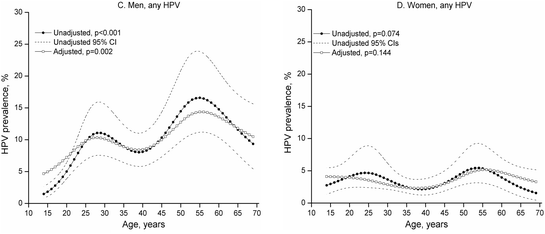

Fig. 2
Modeled HPV prevalence across age in the US population aged 14–69. Gillisson et al. JAMA 2012
Men had a significantly higher prevalence than women for overall oral HPV infection. The age and gender have also been confirmed as independent risk factors for HPV infection in a multivariable analysis, when the other significant risk factors including the number of the life time sexual partners and current smoking intensity have been considered.
The prevalence of oral HPV infection was significantly higher among men than among women, even after accounting for higher-risk behaviors reported by men. Significant interactions were observed between sex and age. Therefore, multivariable analyses were performed stratified by sex. A significant bimodal distribution across age was observed for men, but not for women (Fig. 2).
Chaturvedi et al. (2015) analyzed data for NHANES 2010–2012 represented by 219,608,892 individuals. Overall oral HPV infection was 6.8 %, but significantly higher among men than among women. (10.5 vs. 3.1 %, P < 0.001). The groups of oncogenic HPV and HPV 16 only were also more numerous among men than among women (Fig. 3). The prevalence of the oral HPV infection was similar in groups of NHANES 2010–2012 and 2009–2010.
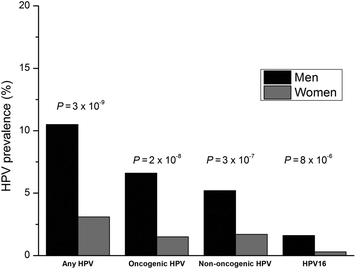

Fig. 3
Prevalence of any HPV infection, oncogenic HPV infection, non-oncogenic HPV infection and HPV type 16 infection among men (black bars) and women (gray bars). Chaturvedi Clin Cancer Res 2015
In unadjusted analyses, demographic factors significantly associated with oral oncogenic HPV prevalence among men included older age (with a bimodal pattern), race/ethnicity, high school or equivalent education, marital status, current smoking (including serum cotinine levels) and marijuana use. Among women, age, race/ethnicity and serum cotinine levels were associated with oral oncogenic HPV prevalence. However, despite these factors, the gender remains the independent risk factor for oncogenic HPV infection. The analysis of US population of men and women separately across the subgroups defined by other key risk factors including age, tobacco smoking and number of the lifetime sexual partners has revealed further contrasts. The prevalence of oncogenic infection was significantly higher among men than among women across all subgroups (Figs. 4 and 5).
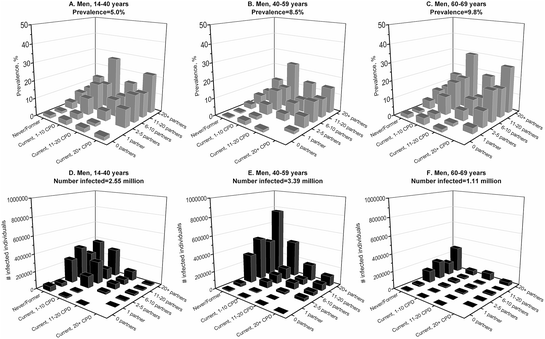
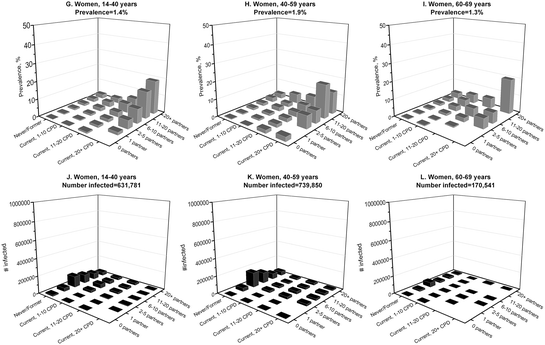

Fig. 4
Burden of oral oncogenic HPV infection among men in the USA

Fig. 5
Burden of oral oncogenic HPV infection among women in the USA. Chaturvedi Clin Cancer Res 2015
The difference in a prevalence of the burden of oncogenic infections among men and women correlating with the incidence on the HPV-related OPC in these groups is evident. The explanation of that fact seems to be attributable to both behavioral and biological differences between men and women. The majority of oral oncogenic HPV infections among are attributable to sexual behavior. Yet, men had substantially higher prevalence than women. This higher prevalence among men is partly explained by the significantly higher number of lifetime sexual partners reported by men. However, only 18 % of the male–female difference in prevalence can be clearly explained by differences in risk behaviors (i.e., smoking and number of sexual partners) between men and women.
The biological differences between genders may also contribute to the increased susceptibility of men to oral HPV infection. The immune responses to parasitic, bacterial and viral infections, but also vaccination, have been determined to vary between men and women. Men are characterized by generally weaker immune response (Klein 2000). Most of the available data come from the studies of anogenital HPV infections equally prevalent among men and women in younger ages. The data support the hypothesis that the seroconversion rates following genital HPV infection among men are lower and there are lower antibody titers upon seroconversion (Markowitz et al. 2009). Moreover, some studies clearly confirmed the absence of acquired immunity against reinfection among men (Lu et al. 2012) and the absence of age-related declines in genital HPV prevalence among men (Giuliano et al. 2011). Genital and oral HPV viral loads among men are also significantly higher than among women (Chaturvedi et al. 2014).
3 Sexual Behavior
Oral HPV infection, associated with the development of OPC, is predominantly sexually transmittable. The analysis of the multiple heterogenous populations in different parts of the world clearly indicated that more than 90 % of all oncogenic HPV infections are transmitted by the given form of the sexual contact and revealed that infection is an uncommon phenomenon in sexually inexperienced individuals. The infection prevalence is eightfold higher among sexually experienced individuals and increased significantly with number of sexual partners. Lifetime number of oral sexual partners has been previously considered to be the behavioral measure most strongly, consistently and specifically associated with oropharyngeal cancer (Marur et al. 2010). The risk of infection by sexual contact is, however, multifactorial. It depends on both the number of sexual partners during lifetime and the form of sexual contacts. Gillison et al. (2012) has performed a comprehensive analysis of the NHANES 2009–2010 study group in terms of sexual behavior. She analyzed the type of the sexual contact (any form of sexual contact, vaginal, oral or anal), the lifetime number of sexual partners, number of sexual partners within last 12 months but also the frequency of particular contacts and sexual orientation.


Fig. 6
Association of number of lifetime sexual partners with prevalent oral HPV infection. Gillisson et al. JAMA 2012
The analysis revealed that oral HPV prevalence was more than eightfold higher among individuals who reported ever having had sex versus not. Prevalence of HPV increased with lifetime or recent number of partners for any kind of sex, vaginal sex or oral sex. One in five individuals with more than 20 lifetime sexual partners was infected. Prevalence was higher among individuals who first performed oral sex at 18 years or younger.
A recent analysis of the NHANES data (2009–2012) (Chaturvedi et al. 2015) demonstrated the per sexual partner increase in high-risk oral HPV prevalence to be threefold greater for men than for women, consistent with reported higher transmission rates for HPV from female to male than vice versa. Also noted was a plateau in prevalence among men at approximately 15 oral sexual partners in contrast to approximately five partners among women (Fig. 7).


Fig. 7
Gender, sexual behavior and oral HPV. Chaturvedi Clin Cancer Res 2015
Thus, the prevalence of oral HPV infection continues to increase among men with more than five partners, but not among women. This sex difference may reflect reduced seroconversion rates among men versus women after genital HPV infection Giuliano et al. 2015, resulting in greater protection against subsequent oral infections among women. Natural seroconversion to genital HPV16 infection reduces risk of subsequent infection among women by approximately 50 % Ho et al. 2002. Thus, increased oral sexual behaviors among recent birth cohorts of men and women would result in greater prevalence increases for oral HPV infection and consequent accelerated rates for HPV-positive OPC in men versus women over the last several decades in the USA.
Kreimer et al. (2013) analyzed the 1626 men aged 18–73 years coming from Brazil, Mexico and the USA who were HIV-negative and reported no history of anogenital cancer and were recruited into the HPV Infection in Men (HIM) cohort study. According to their analysis, marital status was strongly associated with risk of acquiring any and oncogenic oral HPV infections, with married or cohabiting men at a significantly reduced risk in both categories. Marital status seems to be more predictive of oral HPV acquisition than lifetime number of sexual partners does. Also in multivariable models, the effect estimates for marital status remained unchanged after adjustment for lifetime number of sexual partners. The sexual orientation was also associated with risk of oral HPV infection in our study, with bisexual men at the highest risk. These findings suggest that marital status and sexual orientation could reflect a participant’s likelihood of engaging in risky sexual behaviors and partnerships, or differences in a participant’s sexual network, and that these characteristics might be more predictive of risk than lifetime number of sexual partners.
4 Smoking
Smoking and use of other forms of tobacco are the strongest causative risk factors for the development of the squamous cell carcinoma of the head and neck. Because of significant decrease in smoking in the western world in the past decade, the incidence of the tobacco-related HNSCC is slightly lower. However, use of tobacco products may also have an impact on the development of HPV-related head and neck tumors by facilitating the oral HPV infection. For the cervical cancer where the HPV infection is the necessary cause, the tobacco smoking is an established co-existing risk factor (Bosch and de Sanjose 2007).
Stay updated, free articles. Join our Telegram channel

Full access? Get Clinical Tree



